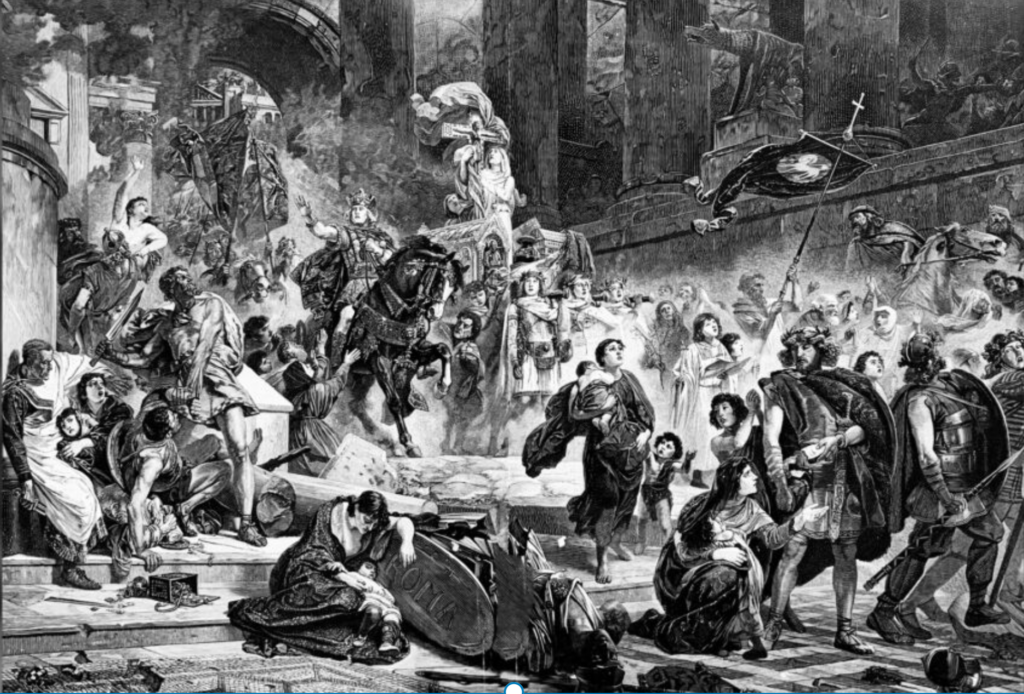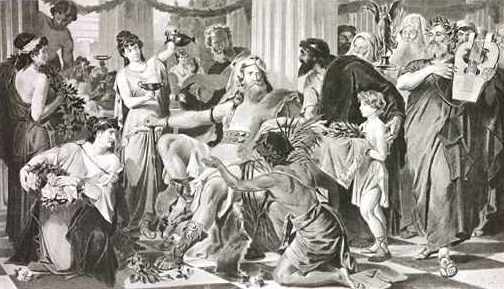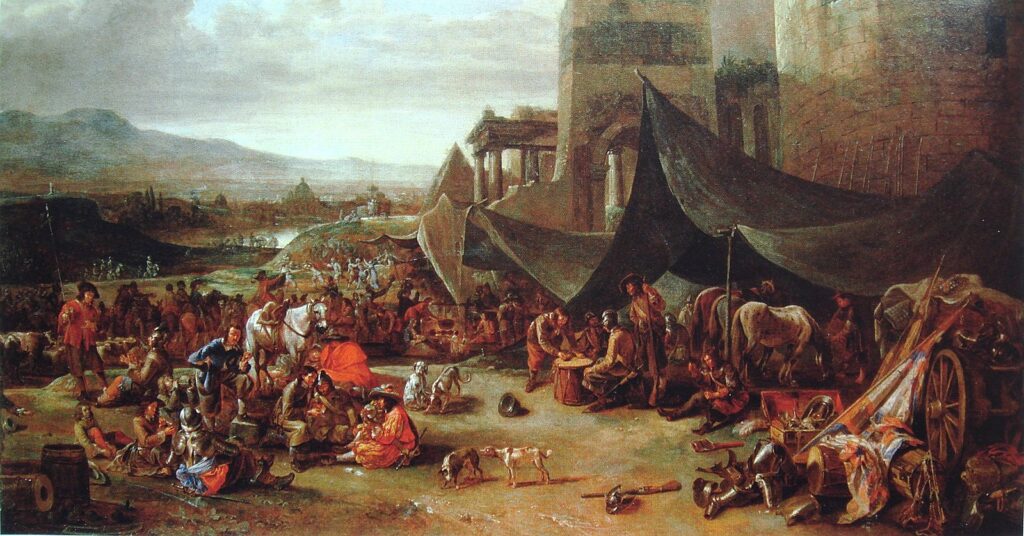The Goths were a significant ethnic group in Europe during the first half of the first millennium of the Common Era. They first appear in the historical record in the first century AD.
They eventually spawned kingdoms that clashed with the Huns, the Romans, and the Umayyad Empire. They spoke an East Germanic language that died out sometime around 800 AD.
The Gothic language was most similar to Proto-Germanic and Ancient Norse. A Gothic alphabet was invented in the fourth century by a Greek-Gothic bishop in order to translate the Bible into the Gothic language.
The Goths played a major role in the fall of the Roman Empire. They then dispersed and eventually assimilated into other cultures.

Where did the Goths come from?
The earliest speculation about the origin of the Goths was written by a Christian scholar named Ambrose who lived in the fourth century AD. He wrote that, like the biblical figures Gog and Magog, the Goths were barbarians who came from islands to the far north.
Like the Vandals, the Goths appear to have migrated south from what is now Poland. Before that, they likely originated in Scandinavia.
Around 550 AD, a Roman bureaucrat named Jordanis wrote the Getica. This is one of the most significant historical documents detailing the various migrations of Gothic peoples.
Believed to have been descended from the Ostrogoths, or the Eastern Goths, Jordanis took much of his information from twelve volumes on the history of the Goths written by the historian Cassidorius. This synopsis by Jordanis is all that remains; the extensive history written by Cassidorius has never been found.
The Getica begins with the emigration of Berig, a legendary Gothic king, and his people. They came from a place called Scandza – understood to mean Scandinavia – and settled in Gothiscandza, which scholars believe was the Vistula Basin of modern-day Poland.
There are many mythical elements to the Getica, including god-kings and dealings with Egyptian pharaohs. It comes back to a more factual account of when the Goths came into conflict with Roman forces in the third century AD.
According to the Getica, Scandza was an island. The Greeks had long since coined the name Scandia to describe the unexplored islands and peninsulas of Northern Europe.
The Goths probably came from Götaland, the southernmost part of the Swedish peninsula, or Gotland, a large island off the coast of Sweden.
Gothic Paganism and The Conversion of the Goths
In the beginning, the Goths practiced a form of paganism. Their polytheistic religion was overseen by reiks, who were both the political and religious leaders of most clans.
Little is known of the gods of the Goths, but they likely worshiped some variation of the god Odin and his son Thor.
They may have a god by the name of Gaut (probably another name for Odin) who was said to be their ancient ancestor hailing from the lands around the Black Sea. In their mythology (and possibly in reality), their people came from these lands and eventually returned to them.
Ancestor worship was an important part of their culture. Many battles began with songs that recounted the stories of their forefathers and praised their great deeds.
The Goths first encountered Christianity when they came into contact with the Roman Empire in the third century AD. In 251 they raided Roman provinces, killed a Roman emperor, and took a number of Christian captives.
Often, the children of the Christian women taken captive by the Goths became Christian Goths themselves. The grandson of one of these captives became a bishop who presided over the creation of a Gothic translation of the Bible.
As their contact with the Christian world increased, many Goths began to convert to Christianity. The new religion spread quickly, and within a few generations, it became the majority religion among some Gothic groups.
Many Goths fought back against this cultural conversion. One fourth-century ruler called Winguric burned over three hundred Gothic Christians to death when they refused to worship a pagan idol.
This was a part of King Athanaric’s systematic attempts to deter conversion by persecuting Christian Goths – not all Christians, but rather people of his culture who had converted and thereby forsaken their ancestors.
In 405, a Gothic king called Radagaisus invaded Italy. He was a devout Pagan, and he intended to sacrifice Rome’s Christian Senators to his gods.
But he was defeated, and some twelve thousand of his soldiers were made to join the Roman army. Tens of thousands of others – lesser soldiers and the families of military men who traveled with the army – were sold into slavery.
These slaves and conscripted soldiers bided their time and joined King Alaric’s forces when they attacked Rome five years later – more on that in a moment.
The Ostrogothic Kingdom of Italy controlled the area in the fifth and sixth centuries. Under their rule, Arian Christianity became popular.
Arian theology holds that Jesus is simply the son of God rather than being part of the Holy Trinity, and Rome regarded this stance as heresy. This sect of Christianity called itself the Church of the Goths.
Alaric I and The Visigoths
This group of Goths came together under the rule of King Alaric (370 – 411 AD). He was their first Christian leader and belonged to the Arian sect. They came from Moesia, an area that included parts of modern-day Serbia, Albania, Macedonia, and Bulgaria.
‘Visi’ may have referenced their western provenance or it may have been their tribal name. Their movement from east to west was driven in part by the Huns, whose persistent attacks forced the Goths west into the Roman Empire.
In his youth, Alaric was a part of the Roman army. By his mid-twenties, he was the king of the Visigoths. Throughout his reign, the Visigoths and other Gothic peoples came into frequent conflict with the Roman Empire.
Under his rule, the Visigoths raided Rome in 410 AD.

Two years before the Sack of Rome, Alaric descended upon Rome with thirty thousand men and blockaded the city. Tens of thousands of Gothic slaves joined his ranks.
Alaric’s forces seized control of the river and cut all supply lines. He demanded all of Rome’s riches and all of the barbarian slaves.
Rome was the largest city in the world at this point in time, with a population of around eight hundred thousand people.
When its citizens began to die of starvation, Rome agreed to pay a staggering ransom: five thousand pounds of gold, thirty thousand pounds of silver, three thousand pounds of pepper, four thousand silken tunics, and three thousand scarlet hides.
In 410, Alaric attacked Rome again. Likely aided by Gothic slaves within the city, his forces entered and raided Rome for three days. This was the first time in eight centuries that the city of Rome had fallen to foreign enemies.
It was a desperate move on Alaric’s part, an admission that he would never achieve the legitimate place within the empire that he had tried to negotiate for over the intervening years.
Alaric’s army seized much-needed provisions and slaughtered countless thousands of citizens in and around the city of Rome. He died soon after, and the bulk of his forces eventually settled in Gaul.
The Visigothic Kingdom eventually grew to encompass most of what is now Spain and the south of France. The Visigoths founded the only new cities to be created in Europe during the fifth, sixth, seventh, and eighth centuries. These cities included Reccopolis, Victoriacum, Isidore, and Ologicus.
The Visigoth civilization featured aqueducts that brought water to public baths. Visigoth nobles were highly educated; they studied philosophy, medicine, and the law. This kingdom endured until the Muslim conquest of Spain in the early eighth century.

What happened to the Goths?
The last ruler of the Ostrogoths was Teia, a ruthless military leader who died in battle in the year 553. This fight, the Battle of Mons Lactarius, was the final defeat of the Goths by the Romans.
Following this defeat, the Ostrogothic Kingdom disintegrated. The Gothic people assimilated into other cultures.
The Visigoths went a similar way, declining as a power and assimilating into the local populations who were by then speaking Romance languages. Gothic influenced these languages, and Gothic loanwords can still be found in Spanish, Portuguese, and Italian.
A small subset of Gothic people known as the Crimean Goths survived a thousand years longer than their counterparts in the West. They were still active in the sixteenth century, and a contemporary Flemish diplomat wrote that they were “a warlike people, who to this day inhabit many villages”.
The Crimean Goths may have descended from the Ostrogoths, or they may have been a separate subset of Germanic peoples who were merely influenced by the Goths. They may have even descended from Anglo-Saxons who immigrated to the Crimean Peninsula around 1100.
Some scholars believe that the Germanic dialect spoken by the Crimean Goths was still spoken as late as 1945, but it has since ceased to be a living language.

